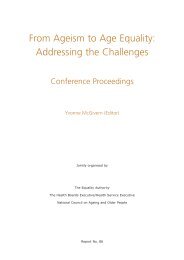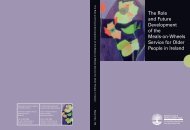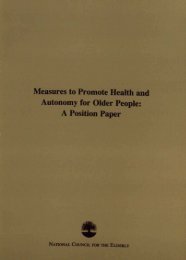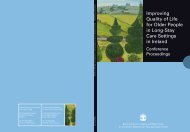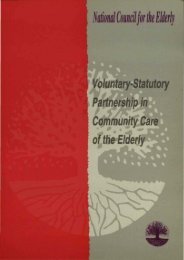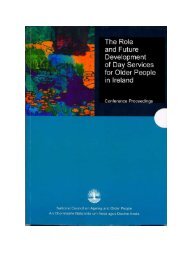Improving Quality of Life for Older People in Long-Stay Care ...
Improving Quality of Life for Older People in Long-Stay Care ...
Improving Quality of Life for Older People in Long-Stay Care ...
- No tags were found...
Create successful ePaper yourself
Turn your PDF publications into a flip-book with our unique Google optimized e-Paper software.
<strong>in</strong>spections are ma<strong>in</strong>ly concerned with physical conditions and health andsafety. There is little reference to quality <strong>of</strong> life or social ga<strong>in</strong> issuesthe regulations do not provide a framework to monitor residents’ care plans.There are no mechanisms to identify how much long-stay care is required,how it is to be provided and whether the <strong>in</strong>dividual needs <strong>of</strong> residents havebeen metit is difficult to prosecute nurs<strong>in</strong>g homes that violate exist<strong>in</strong>g regulationsand it is rare that a nurs<strong>in</strong>g home will be closed down even if a breach <strong>of</strong>the regulation is proventhere is no published analysis <strong>of</strong> the <strong>in</strong>spection reports <strong>of</strong> private facilitiesthe recommendation <strong>of</strong> The Years Ahead report and the 2001 healthstrategy, <strong>Quality</strong> and Fairness: A Health System <strong>for</strong> You, that an <strong>in</strong>dependent<strong>in</strong>spectorate be established has still not been implemented. It is plannedthat the Bill establish<strong>in</strong>g the Social Services Inspectorate on a statutory basiscover<strong>in</strong>g both public and private long-stay facilities will be published <strong>in</strong> the nearfuture. The <strong>for</strong>thcom<strong>in</strong>g Bill will also <strong>in</strong>clude a specific provision to allow easyaccess by the public to <strong>in</strong>spectors’ reports on nurs<strong>in</strong>g homes (DoHC pressrelease, 2005).there is no common, standardised approach to nurs<strong>in</strong>g home <strong>in</strong>spectionswhich leads to an <strong>in</strong>consistent application <strong>of</strong> standards throughout the country.The tra<strong>in</strong><strong>in</strong>g <strong>of</strong> <strong>in</strong>spectors is neither comprehensive nor uni<strong>for</strong>mthere is no statutory <strong>in</strong>dependent compla<strong>in</strong>ts and appeals system with<strong>in</strong> thehealth service. Nor is there an organised advocacy service <strong>for</strong> vulnerable olderpeople <strong>in</strong> residential carethe Code <strong>of</strong> Practice <strong>for</strong> Nurs<strong>in</strong>g Homes is not legally en<strong>for</strong>ceable and there isno means <strong>of</strong> assur<strong>in</strong>g the standards outl<strong>in</strong>ed <strong>in</strong> it are respected and adhered toby nurs<strong>in</strong>g homesthe remit <strong>of</strong> the Ombudsman only extends to public long-stay care facilitiesand not to private or voluntary nurs<strong>in</strong>g homes, although public policy <strong>for</strong> privatehomes is coveredthe system <strong>of</strong> l<strong>in</strong>k<strong>in</strong>g the amount <strong>of</strong> subvention paid to the dependency level<strong>of</strong> residents <strong>in</strong> private nurs<strong>in</strong>g homes has encouraged ‘dependency creep’,with some older people be<strong>in</strong>g placed <strong>in</strong> the highest dependency category<strong>in</strong> order to qualify <strong>for</strong> the maximum subvention payment49







